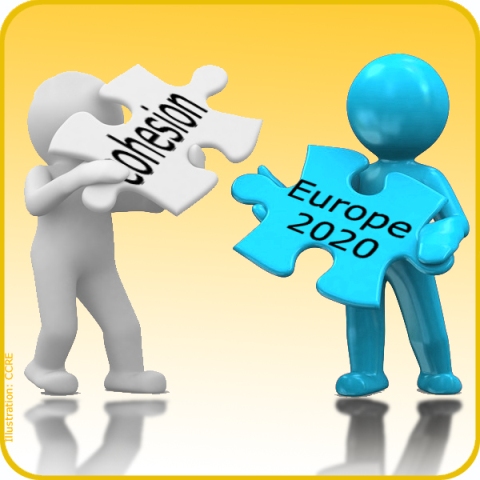JULY 2017
What do the construction of a new motorway linking two sides of a main Czech region and the restoration works of Pompei archaeological site have in common? Without any doubts, both are improving the daily life of European citizens: the first project will assure a faster and safer route crossing the Moravia region while the second one will gift tourists, both European and from all over the world, one of the most famous Ancient Roman site in its full magnificence. But the benefits are not finished yet. Indeed, it has been estimated that a faster motorway throughout Czech Republic will produce 28.2 million in time saving for road user per year while a fully restored Pompei is foreseen to attract an average of 200 000 extras visitors per year. Is clear that these projects entail a value added for common citizen’s living standards.

But the meaningful profits yield for the full advantage of the population are not the only things these projects have in common. In fact, both are co-funded by the European Union, specifically by the Regional Policy Funds, which seeks to support job creation, competitiveness, economic growth, improved quality of life and sustainable development. The Regional Policy represents almost one third of the European Union budget and is addressed to projects aiming to improve and equilibrate the development of different European regions and cites. Hence, in every Member States companies, universities or research institutes, municipalities and regional district could count on the European support for launch innovative researches, environmental friendly projects or restore infrastructure and historical buildings, for the direct benefit of all European citizens. These funds are made available with the precise aim of support the Union’s Members when the State alone is not capable to support important projects for the growth of the country.
Regional Policy and the other different and more specific funds included in it, is one of the main and most direct instruments that both States and citizens could deploy for compensate the shared burden entailed inside the Union membership. As each Member is contributing to the European budget, investment plans such as the Regional Policy or the Cohesion Policy have been exactly designed in order to pay back the effort made by the States and create a more inclusive and equal Union.
Despite the meaningful role of the EU as co-financier, these projects are often not even remembered as one of the benefit of the European citizenship. Besides the more proclaimed right to cross borders without the need of a passport of visa as well as the right to move into another member state seeking jobs or a retire heavens, the ongoing work the European Union is doing in the direct interest of common people is usual bypassed by both medias and national governments. Investments policies are a part of this hidden work of the Union. Even if the support of national researchers could not be meet the direct and immediate interests of common citizens, or the support of local farmers involves only the workers of a specific sector, the construction of a new highway and the restoration of important archaeological sites are improvements clearly under everyone’s eyes. Nevertheless, the direct aid provided by the Union is not just underestimated; it’s unacknowledged or even ignored. During such times of deep mistrust hitting hard political elites and institutions, a more balanced and enlightened knowledge of how living the Union is directly affecting our lives is needed.
As all bureaucratic aspects of the Union, also the administration and the division of such funds is a complicated maze of embedded boxes.
All investments are linked to the European Structural and Investment Plan (ESIP), which aim is to contribute to the achievement of the Investment Plan based on Commission’s Priorities. These Priorities cover a wide arrange of issues, from the need of a more democratic Union to the effort of improving Internal market fairness, shifting from the creation of a Digital Single Market and a common European agenda on Migration. However, the ESIP is not only contributing to the realization of the Commission’s goals on the future of the Union but as a big box is containing different compartments of funds directed to more specific areas or to the general improvement of the Union’s quality.
The biggest compartments is represented by the already described Regional Policy (RP) that is itself divided into three minor boxes of funds: Cohesion Funds (CF) directed to Member States with Gross National Income per citizen 90% below the European average, the goal is to reduce economic and social disparities within the Union; European Regional Development Fund ( ERDF) directed to different regions of the Union, in this case funds are not managed by the State but by the regional government and its main area of interest includes enterprise and regional economies development ; European Social Funds (ESF) are as the later directed to European regions but differently from the ERDF, these funds deal with poverty causes, social exclusion and unemployment.
In order to complete the frame, beside the Regional Policy box, the ESIP includes also funds supporting farmers (European Agricultural Development and Rural Development) and fisheries (European Maritime and Fisheries Fund). The system of funds is therefore covering a wide share of European issues, entering inside the daily life of European citizens with the aim to improve the realities where they live not only the general development level of their countries. Despite the direct interference the Union is having on their present and future, Member States citizens are still struggling to fully recognize the benefit of being European, as the Brexit referendum clearly demonstrated.
The causes of such “bad evaluation” of the grants offered by the European citizenship are difficult to delineate with a solid certainty. However, is still possible propose some explanations concurring to the phenomenon. Indeed, the refusal to recognize the value of the support of the Union give to every country seems due to two different and opposite patterns. The first one refers to the European citizens attitude to consider all benefit coming from the EU as granted, as ever existed and therefore impossible to being taken back. This attitude led to a distorted evaluation of what would be the future outside the Union. Indeed, a harsh discussion is occurring inside the Brexit negotiation on whether or not British citizens will be allowed to keep their European citizenship, and what the title will truly implicate. On the other side, all benefits both evident and more hidden ones are seen as outnumbered and overwhelmed by the costs coming from the membership. Here again, Brexit case teach us an important lesson on citizen’s vision of the cons linked to European membership. The Leave campaign was based on two main promises: to take back control of the borders and cut immigration (wrongly estimated to rise after an “imminent” admission inside the Union of countries like Turkey, Macedonia, Montenegro and Serbia) and to take back the 350 million pounds UK was giving weekly to the European Union. Beside the incorrectness of the data, as the total pounds truly reaching the EU budget is 276m, almost the half of this sum is spent for providing aids to British farmers, support researches of British universities and innovation inside British companies, throughout the funds managed by the European Union. The relevance of the recognition of the real benefit brought by these funds is therefore evident: if citizens don’t know how their money is truly spent, then the balance appears clearly pending on the side of the costs.
Is therefore missing one side of the narrative, and the untold part is leading European citizens to have a confused and bias vision of the Union. However, citizens are not he one to blame: both media and national governments have concurred to the construction of this mistaken reality. Indeed, media are usually taking advantage from unease situations for increase their sales, instilling fears and paranoia on the public opinion assures the creation of the perfect scoop starting from a far less shocking episode. The exaggeration and exploitation of news that led to a contorted vision of the reality is a serious nowadays issue. However, this pattern is also damaging the European Union reputation in front of its own citizen’s eyes. Moreover, national governments, politicians and elites, even if declared pro-Europe, have usually used the Union as a scapegoat, with the aim to avoid national public opinion critics on debated national policies or laws. Claiming that their responsibility toward the Union “made them” to do what they had to do, national governments are slowly but constantly eroding citizen’s right of accountability, worsening their mistrust toward the Union, seen as no more than an outsider dictator forcing their government to take actions against the will of the population. Thus, the raise of “Euroscepticism” among all Member States is not surprisingly at all. However, if the Union hopes to enhance cooperation and integration among Member States, before it must convince its own citizens of the benefits entailed inside the membership. European Union must publicize those benefits, and not only the usual claimed one, but must show to the common people its hidden work aimed to improve their daily lives.
Visits: 116

